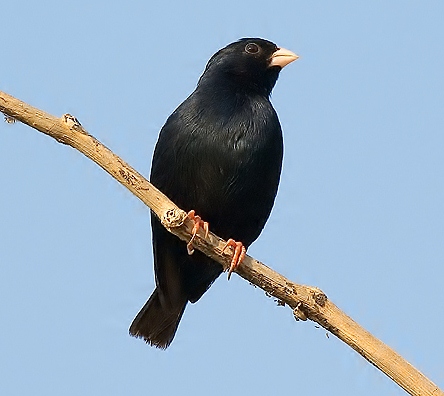 |
| Photo by Rob Nagtegaal (PBase) |
Common name:
village indigobird (en); viúva-azul (pt); combassou du Sénégal (fr); viuda de la villa (es); rotfuß-Atlaswitwe (de)
Taxonomy:
Order Passeriformes
Family Viduidae
Range:
This African species is found from Senegal to Ethiopia, and south through Tanzania, Zambia and Malawi and into Mozambique, eastern Botswana and north-eastern South Africa.
Size:
These birds are 11-12 cm long and weigh 12-13 g.
Habitat:
Village indigobirds are mostly found in dry Acacia savannas and scrublands, especially along rivers, but also in sparse woodlands, plantation, arable land and gardens within human settlements.
Diet:
They mainly eat grass seeds, but will also take some insects.
Breeding:
In southern Africa the village indigobirds breeds in December-June. They are polygynous, with each male mating with several females. Village indigobirds are brood parasites, usually laying their eggs on the nests of the red-billed firefinch Lagonostica senegala, as well as other firefinch species such as the brown firefinch Lagonostica nitidula. Each female lays 1-4 eggs per day, for a total of 22-26 per season, and usually removes or eats the eggs of the hosts. The hosts incubate the eggs for 11-12 days and feed the chicks until they fledge, 17-18 days after hatching, and often continue to feed them for another 2 weeks.
Conservation:
IUC status – LC (Least Concern)
This species has a very large breeding range and is described as common to locally common. The population is suspected to be stable in the absence of evidence for any declines or substantial threats.







